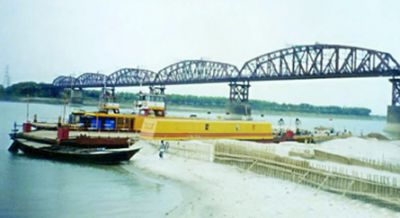Hardinge Bridge
Hardinge Bridge a steel railway bridge made up of prefabricated trusses and named after Lord hardinge, the Viceroy of India (1910-1916). The bridge crosses the lower ganges at Sara between Paksey and Bheramara stations on the broad gauge railway from khulna to parbatipur.

The construction of the Hardinge Bridge was proposed and discussed for more than twenty years before it was finally sanctioned for construction in 1908. Proposals put forward by the then eastern bengal railway in 1889, were investigated by a committee and reported to be feasible. In 1902, Sir FJE Spring prepared a detailed project on the bridge. There were many discussions as to the site of the bridge and in 1907 a committee representing commercial interests recommended one of the 'Sara' sites which had been favoured by Sir Spring.
A technical committee appointed in 1908 reported that a bridge could be constructed in a site near Sara, ie present site. The construction of the bridge started in 1910 and finished in 1912.
It may be mentioned here that the British engineer Sir Robert Gailes worked as the chief engineer of the construction. On the 1st of January 1915, the first trial train crossed the bridge down track and on 25 February of the same year the second trial train crossed the bridge up track. Finally on 4 March 1915 Lord Hardinge inaugurated the bridge. A total of 24,000 people were employed for constructing the bridge.
The Hardinge Bridge is 1.8 km long. There are 16 piers of castion type made of concrete cubes. A portion of pier above water level is made of steel. The bridge comprises 15 steel truss through spans each of 345 feet 11/2 inches from centre to centre of bearing (308 feet 11/2 inches clear span) with 6 deck type steel girders by approach spans (3 at each end), each of 75 feet centre to centre of bearings (66 feet clear span approximately). The original steel of Hardinge Bridge is of mild steel type equivalent to grade 43 of BS 4360 having yield stress of 20.8 tons/sq inch; ultimate tensile strength of 30.6 tons/sq inch at an elongation of 23%. The original design loading for the girders was Indian Railway broad gauge B of 1903+33% with an impact allowance giving a total live load of 1927 tons on two tracks.
During the war of liberation the twelfth span of the Hardinge Bridge broke down into the river by mortar shelling. One end of the span was hanging dangerously with the base and a 12.2m part from the other end collapsed. A cruise guarder and two striggers of the fifteenth span and the steel tassel upon the second base were also damaged by mortar shells. After the liberation the bridge was reopened on 12 October 1972, repaired by the joint venture of Bangladesh Railway and the Eastern India Railway of India. But some part of the bridge had to be changed and updated.
The broad gauge lines are laid side by side with a separate footpath on the downstream side. A high-tension electric line is passed over upstream side of the bridge. The headroom of the bridge is rested by the structural frame up to a height of 6.71m from the floor level. Jamuna Multipurpose Bridge Authority (JMBA) has a plan to renovate the bridge so that light and heavy vehicles can also use it. [Sifatul Quader Chowdhury]
